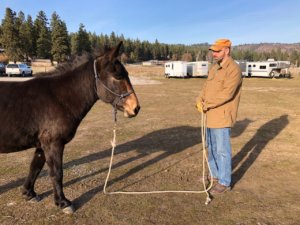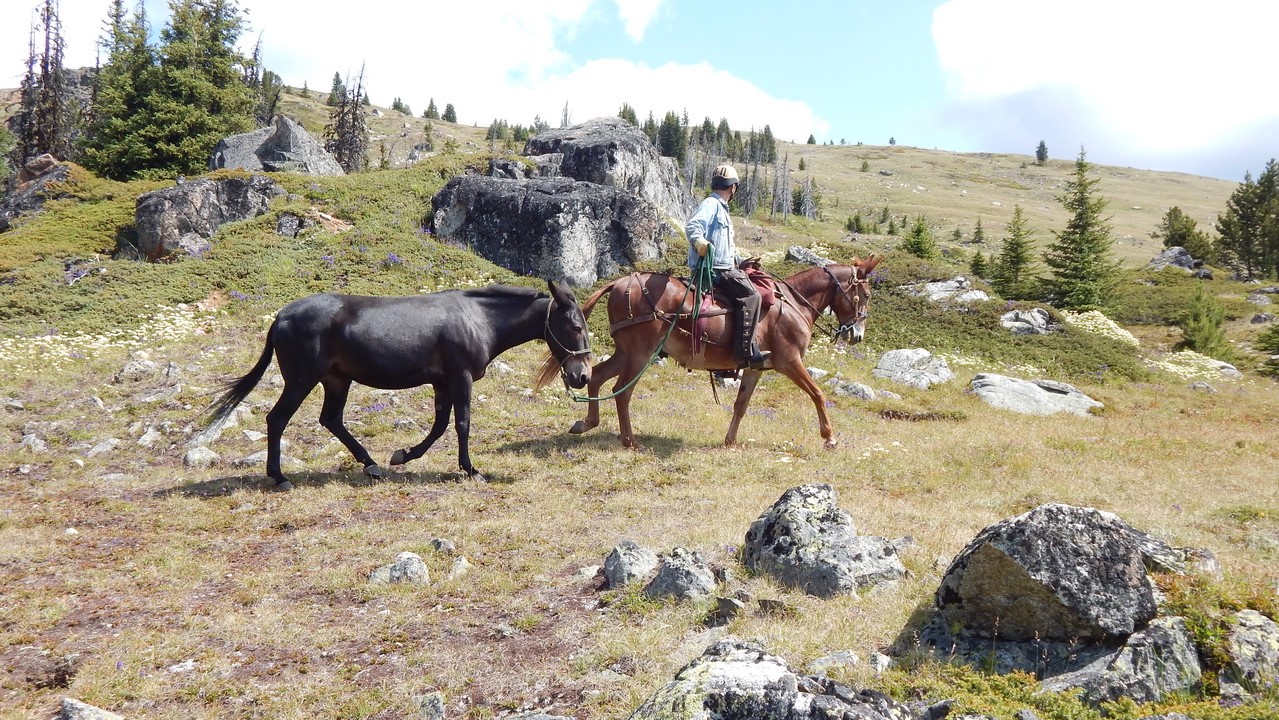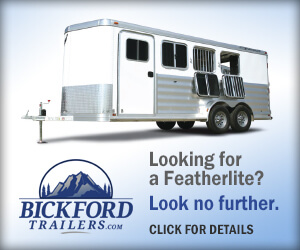Are you able to lead another horse from your horse? Is your equine able to be led by another horse? These are skills you and your horse should be able to do. Ponying is not just a talent for packers but an essential skill for every trail rider.
Put simply, ponying is the act of leading a horse alongside the animal you’re riding. It sounds simple but it’s a multifaceted job of riding your own horse while also paying attention to another, all while holding the reins in one hand and a lead rope in the other.
Why would anyone want to do this? Here are a few examples:
- Introduce a new horse to the trail
- Lead a pack horse
- Assist another rider
- Condition a young or older horse
In each of the above cases, you’ll need to know how to pony correctly to keep you, your horse, and the ponied horse safe.
Prepare Yourself
For successful ponying you need to be comfortable riding one-handed. You must be able to rein with either hand while holding a lead in the other. Be able to switch hands on the go.
Prepare Your Riding Animal
Before attempting to lead another animal, your riding horse or mule should be comfortable with having ropes all around him. He needs to be okay with feeling a lead rope alongside his hindquarters, and even with the possibility that the rope might get around a leg or under his tail.
When I’m working with my horses and mules I’m constantly tossing the lead rope around their hips, along their legs, and asking them to bend their necks and come around to face me. I do this from all sides — left, right, front, and back. Once you can do that from the ground it’s time to try the same exercises from the saddle.
Your riding animal should calmly allow ropes to touch his legs and tail and should be able to drag logs without spooking. You don’t have to be a professional roper, and a lariat isn’t necessary. Just swing a lead rope to accustom your horse to the motions on both sides. Be careful.
I feel rope training is an essential exercise for every animal. Your riding animal needs to be responsive but not afraid of a rope.
Prepare the Horse to be Led

It’s my opinion that every trail horse should be able to be ponied. There are a number of reasons why, but my biggest is that if you depart your ride unexpectedly (say in a helicopter) your riding partner should be able to safely pony your horse back to the trailhead.
Start from the ground before leading from another horse. The horse you plan on ponying should be able to be led (and led well) from the ground before you try it from the saddle. Once the pony horse prospect has good ground manners and is light and alert at the end of a lead rope, transitioning to ponying won’t be traumatic. Work from the ground until your prospect is consistent and responsive from a distance.
This groundwork prepares your horse to be led from horseback and also helps him become a better, more respectful partner that doesn’t pull or crowd you — both good things.
Equipment
- A functional saddle with a solid tree. Treeless or flexible-tree saddles can deform and unevenly distribute pressure causing pain to your riding horse.
- A rope halter for the horse to be ponied. The rope halter will reinforce your cues.
- A 12-foot lead. I’ve used both shorter and longer leads. 12 feet works best for me.
- Gloves. Rope burn is a thing and it’s not pleasant.
The Dally
Once the three of you (your riding horse, the horse to be ponied, and yourself) are ready to head out you’ll be tempted to use your saddle horn. Don’t. Use the horn to hold lunch, not tie off your lead rope. Should a ride become eventful while ponying you want to instantly release all connections to the pony horse. It’s much better to dismount and pick up the lead than to be dragged off the side of a mountain because you were hard-tied to an animal who lost his footing.
Successful ponying is dependent upon the response and respect you develop on the ground. If your horse handles well and is responsive to the halter rope on the ground, the training will come through when you pony him. Take the time to develop those skills.
Published in the August 2020 Issue:

Robert Eversole, ”the trail meister,” owns www.TrailMeister.com, the largest database of horse riding and camping areas in the U.S. with free trail and trailhead information, trail maps, and much more to help horse enthusiasts experience the joys of trail riding. Robert is a registered riding instructor with PATH International, a mounted search and rescue team member, and a U.S. Marine who has served on the board of the Backcountry Horsemen of Washington (BCHW). He is enjoying his new career helping fellow trail riders stay found and safe on the trail. When not on the trail, The Trail Meister resides near Spokane, WA and teaches land navigation to a wide variety of outdoor groups across the nation. For North America’s largest horse trail and camping directory, trail tips, and more, visit www.TrailMeister.com.






